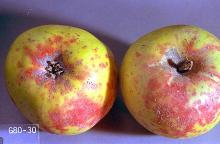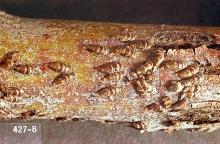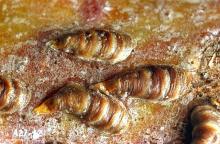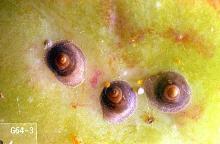Oystershell scale (Lepidosaphes ulmi)
San Jose scale (Quadraspidiotus perniciosus)
Pest description and crop damage San Jose scale was introduced to the U.S. on flowering peach in the 1870s. It is now a pest of all fruit trees and many ornamental and wild trees and shrubs throughout the U.S., particularly in hot, dry climates. Oystershell scale is European in origin and has been in the US since around 1850. San Jose scale can be differentiated from other scale insects by the scale (shell) that covers the adult females. The scale is hard, gray to black, and cone-shaped. The scale has a tiny white knob in the center with a series of grooves or rings around it. Oystershell scale looks like a miniature oyster. Oystershell scale is principally a pest of woody parts of the plant (although it occasionally attacks fruit), while San Jose scale attacks both woody parts and fruit. Scales are closely related to aphids, mealybugs, and whiteflies. Like these insects, they also have piercing-sucking mouthparts. Large populations of scale can devitalize plants and retard growth. Severe infestations by San Jose scale can kill twigs and even the whole tree. Large quantities of honeydew are produced, which makes leaves and fruit shiny and sticky. Sooty mold fungus may grow on this, giving the plants a dirty, sooty appearance. Fruit infestations by San Jose scale initially cause development of red spots around the feeding site.
Biology and life history San Jose scale overwinters in an immature state and is black in color. In spring, the tiny winged males emerge and mate with wingless females. Females give birth to live young about a month later (no eggs are seen). The young scales, called "crawlers," are very small, flattened, and yellow, and move around on bark and foliage before settling down to feed. Young scales also can be dispersed by wind, rain, irrigation, or by the movement of people and machinery. After settling down to feed, the insects become sessile and they secrete a waxy coating over their body that can protect them from pesticides. There are two generations per year, crawlers are usually found during June and July and again in August to September. Oystershell scale overwinters as eggs under the female scale, crawlers emerge in May and June and move to feeding sites on the bark. They secrete a waxy coating and the females remain sedentary. Males emerge from their coating and mate with the females, which lay eggs beneath their bodies, gradually shrinking in size and dying after the last eggs are laid. There is one generation per year.
Pest monitoring Inspect twigs and spurs during the dormant season for scales. Examine wood from the tops of trees and pay particular attention to weak plants. Observe the young bark for purplish-red halos which indicate infestation. The crawlers are best observed during June to July with a 10X magnifying glass. Crawlers can be monitored by wrapping a piece of double-sided tape around an infested branch. Male San Jose scale can be monitored with pheromone traps. Adult males emerge in the spring around the same time as codling moth. Time in-season sprays to match crawler emergence.
Management-biological control
Larvae of green lacewings and other insects are aggressive predators of scale. A number of parasitic wasps will attack scale insects. However, biological control does not necessarily prevent significant scale infestations.
Management-cultural control
Scale can be rubbed off plants by hand with a glove or toothbrush. Major infestations can be pruned off. Tanglefoot, "stickem," or a similar adhesive can be applied around infestations of adult scales to catch the crawler stage. As with aphids and psyllids, avoid excessive nitrogen fertilizer, as this favors increased populations.
Management-chemical control: HOME USE
Dormant-season spray
Apply sprays during dormant or delayed-dormant period (March to April). Do not use after pink appears in buds. Use enough water to cover all of the tree thoroughly, including small limbs and shoots.
- superior-type oil-Some formulations are OMRI-listed for organic use.
- superior-type oil, plus either lime-sulfur or a lime-sulfur material such as polysulfide-Some formulations are OMRI-listed for organic use.
Growing-season spray
- acetamiprid-Toxic to bees.
- azadirachtin (neem extract)-Products containing neem extract may be phytotoxic to some pear cultivars. Some formulations are OMRI-listed for organic use.
- bifenthrin-Highly toxic to bees.
- carbaryl-Highly toxic to bees.
- gamma-cyhalothrin-Highly toxic to bees.
- imidacloprid-Highly toxic to bees. Soil drenches may have residual activity in woody plants lasting for 12 or more months. If short-term management is the goal, consider other approaches.
- insecticidal soap-Some formulations are OMRI-listed for organic use.
- lambda-cyhalothrin-Highly toxic to bees.
- malathion-Highly toxic to bees.
- permethrin-Highly toxic to bees.
- plant-derived essential oils-Some have shown efficacy against scale. Some formulations are OMRI-listed for organic use.
- pyrethrins (often as a mix with other ingredients) -Highly toxic to bees. Some formulations are OMRI-listed for organic use.
- zeta-cypermethrin-Highly toxic to bees.
Management-chemical control: COMMERCIAL USE
Prebloom spray
- buprofezin (Centaur WDG) at 34.5 to 46 oz/A. REI 12 hr. Do not exceed two applications or 69 oz/A per season. Do not tank mix with oil.
- lime sulfur (Calcium polysulfide)-Formulations vary; see label for rates. May be mixed with horticultural mineral oil; see label for rates. REI 48 hr. Some formulations are OMRI-listed for organic use.
- horticultural mineral oil at 4 to 6 gal/A plus an organophosphate material such as diazinon. Check label for REI. Use only those chemicals and formulations that are registered and suggested for Pacific Northwest conditions. One dormant application is allowed. Applications of diazinon require an enclosed cab, see label for details. Note: Continual agitation is necessary when filling the spray tank and during spraying. Apply before new growth, at temperatures above 40°F, prior to hot or rainy weather or drying winds.
- pyriproxyfen (Esteem 35WP) at 4 to 5 oz/A + horticultural mineral oil at 4 to 8 gal/A. REI 12 hr. Do not exceed two applications per season.
Growing-season spray
- acetamiprid (Assail 70WP) at 3.4 oz/A. REI 12 hr. PHI 7 days. Will provide suppression. Do not exceed 4 treatments per calendar year. Do not apply more than once every 12 days. Do not exceed 0.60 lb ai (13.5 oz product) /A per calendar year. Repeated use may induce spider mite buildup.
- buprofezin (Centaur 70WDG) at 34.5 to 46 oz/A. REI 12 hr. PHI 14 days. Do not exceed two applications or 69 oz/A per season. Do not tank mix with oil
- diazinon (Diazinon 50W) at 1 lb plus 2 to 3 gal dormant oil or 1 to 1.5 gal superior type oil per 100 gal water. REI 4 days. PHI 21 days. Applicators must use an enclosed cab, see label for details. One dormant and one in-season foliar application allowed with a minimum of 70 days between applications. Apply as a dormant spray. When using spray oils, follow spray oil manufacturer's use directions. Do not apply more than 4 lb of product or 6 gal of oil per acre. Apply only once during the dormant season.
- flupyradifurone (Sivanto 200 SL) at 10.5 to 14 fl oz/A. REI 4 hr. PHI 14 days. Combine with a horticultural oil for early season applications.
- imidacloprid (Prey 1.6) at 8 fl oz/A. REI 12 hr. PHI 7 days. Repeated use may induce spider mite buildup.
- pyriproxyfen (Esteem 35WP) at 4 to 5 oz/A. REI 12 hr. PHI 45 days. Apply when scale crawlers first emerge. Do not exceed two applications per season.
- spirotetramat (Ultor) at 10 to 14 oz/A. REI 24 hr. PHI 7 days. Follow with a second application 14 to 21 days later. Do not exceed 40 oz/A per season. Minimum 14 days between applications. Must be used with an adjuvant; see label. Do not apply prior to petal fall.




